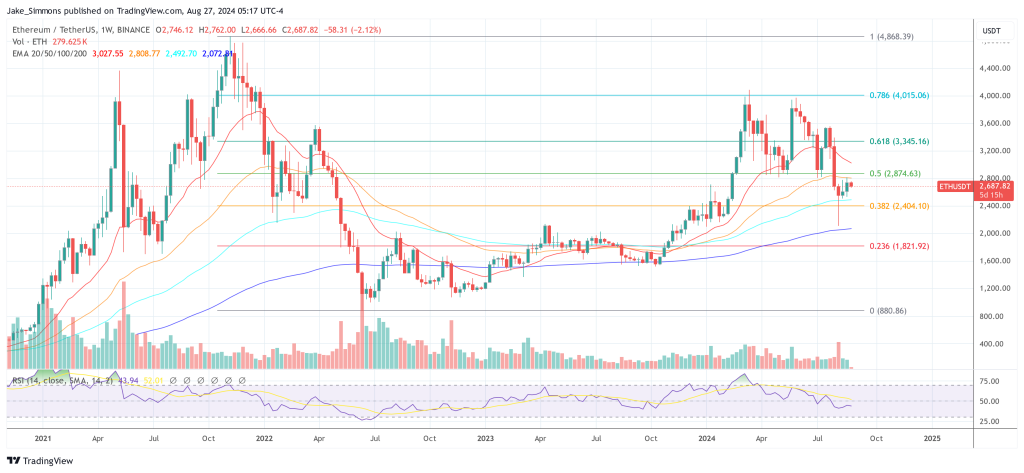Ethereum ‘Dies While L2’s Dance On Its Grave’: Crypto CEO
In a charged statement on X, Justin Bons, founder and Chief Investment Officer of Cyber Capital, one of Europe’s oldest cryptocurrency funds, has voiced a critical view of Ethereum’s current trajectory, asserting that “Ethereum is dying while L2’s dance on its grave.” Bons argues that Ethereum (ETH) is struggling to maintain its fee revenue due to inadequate network capacity, while Layer 2 (L2) solutions are capitalizing on this limitation by keeping Ethereum’s capacity constrained.
Bons claims, “ETH cannot sustain high fee revenue because it lacks the capacity. At the same time, L2s are seeing record highs in usage & fees while they lobby to keep ETH’s capacity down!” He characterizes this dynamic as parasitic, where L2s benefit at Ethereum’s expense, particularly post the EIP-4844 (Proto-Danksharding) implementation, which Bons claims has precipitated a collapse in fee revenue for Ethereum. His commentary suggests that the fee burning mechanism, meant to offset inflation by making Ethereum deflationary, can no longer keep pace due to the fee diversion to L2s.
Is Ethereum Dying Because Of L2’s?
Bons argues that this scenario has created a “parasitic relationship” between Ethereum and its L2 counterparts. He believes that L2s, while designed to scale Ethereum’s capacity by handling transactions off the main chain, are now operating almost independently, thereby fragmenting the ecosystem. This fragmentation, according to Bons, is breaking up liquidity and composability, crucial elements that facilitate seamless operations across the Ethereum network.
The shift towards L2 solutions, in Bons’ view, has led to a rise in centralized tendencies within platforms that were originally promoted as decentralized. “This also pushes the users into centralized L2s. As every single L2 in the top 10 (stopped counting after 10) can now steal user funds & censor. This is ironic, considering that the entire ‘L2 scaling’ roadmap was justified in the name of decentralization… A bait & switch,” Bons elaborated.
The critique extends to the governance model of Ethereum, which Bons claims eschews on-chain governance leading to what he perceives as centralized control over its development. “The total rejection of on-chain governance by the ETH community could only have one outcome: Capture, resulting in what is effectively centralized control over ETH development!” he asserted, suggesting that this governance model has enabled L2 entities to exert disproportionate influence over the network.
If Ethereum were to scale at the L1 level with new technological breakthroughs, Bons speculates that it would “crash the token & equity price of all L2s overnight by making them obsolete & unnecessary,” illustrating a conflict of interest where L2 entities may prefer to suppress L1 advancements to maintain their market position.
Contributing to the debate, Pengu Aaron, lead of the ICP Hub Singapore, remarked, “IMO the L2s have to find a way to contribute back to Eth or else we will see a potential collapse in value.” Bons’ response underscored a systemic issue: “L2s only have to contribute back to ETH from ETH’s perspective. From the L2s perspective, it makes far more sense to keep all of that value for themselves. That is the problem as you are setting up a system with opposing & perverse incentives. Making it entirely unfixable & broken.”
In a contrasting view, a user named @bowtied3hbt drew an analogy to the United States, where the federal system allows states considerable autonomy yet remains functional. Bons countered this comparison, highlighting historical conflicts that were necessary to maintain the federation, such as the Civil War, thus illustrating the enforceability challenges in decentralized systems which lack overarching compulsion mechanisms.
“Multiple wars were fought to keep the US federation together! From the Civil War to the Utah War, to name a few. The difference is that in cryptocurrency, nobody can force an L2 to stay on ETH if it goes against the L2s interests. That is where your analogy totally falls apart!, Bons concluded.
At press time, ETH traded at $2,687.

Featured image created with DALL.E, chart from TradingView.com








